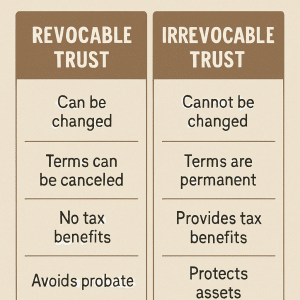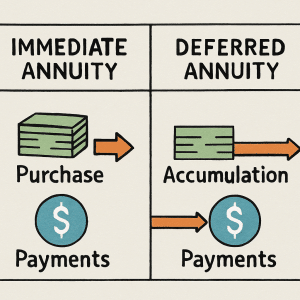What is a Long Term Care Annuity?
A long-term care annuity is a deferred fixed annuity with a long-term care rider that provides enhanced coverage for potential long-term care expenses.
An annuity with a long-term care rider will provide double (200%) to triple (300%) your initial deposit.
How Do Long Term Care Annuities Work?
In the right circumstance, a nonqualified annuity can be an efficient, tax-favorable Long Term Care funding option. Under the Pension Protection Act (PPA), older nonqualified annuities can be exchanged for annuities that offer long-term care benefits — without experiencing a taxable event (via a 1035 Exchange).
Exchanging an idle annuity for one that qualifies under the PPA can help protect your portfolio from a long-term care event; without any real change in your lifestyle.t without changing their lifestyle. In addition, health underwriting requirements are not very rigorous making a long-term care annuity a potentially great option if you are older or health-challenged.
Why it Works
If you require long-term care services you will select a qualified facility or service provider of your choosing. You will submit receipts and invoices to your insurance company which will directly pay your qualified provider.
The benefit is technically a reimbursement benefit meaning you have to pay the cost first and then get reimbursed. However, you do not have to submit the invoices monthly; only initially at the time of claim.
There is a fee to add the long-term care insurance rider to an annuity that is charged from your annuity annually.
Long Term Care Annuity Example: Case Study
Dan and Sara are both age 72 and have an old annuity that is earning 3%. They have a $50,000 cost basis in the policy. One of them has an LTC event in eight years, and they must pay taxes on the gain when they withdraw funds from the old annuity to pay for the care. They spread the withdrawals over three years.
By exchanging for a PPA annuity, however, they save the taxes and potentially have more than $9,000 additional funds to pay for LTC. In fact, Dan and Sara would have to earn over 5% each year to net the same as the new annuity.*
Long Term Care Annuity Tax Benefits
The below chart is an example of how an annuity with long-term care benefit works. This sample illustration shows the benefits provided to a 60-year-old female purchasing a One America Annuity Care II for $100,000.
As you see the Single Premium is $100,000 (purchase premium) and the LTC Balance is $250,176. The $250,176 is the total amount of LTC Benefit this annuity will provide over a 60-month period.
- $4,169 monthly benefit for 24 months from an initial $100,000 deposit
- $4,169 monthly benefit for 36 additional months (Continuation of Benefits)
- Premium + COB Benefit = Total LTC Benefit of $250,176.
As you can see we’ve added a 36-month COB Rider (continuation of benefits). This annuity is very simple to understand. You take your account value and divide it by 24 to get your monthly LTC Benefit.
Your money pays for the first 2 years of benefit and once your annuity account value reaches zero – the COB Rider kicks in to pay the same monthly benefit for another 36 months.

The table below lists the Accumulated value, cash surrender value, LTC total Balance, and COB Annual Benefit for ages 65 thru 100 (using One America’s Annuity Care II).
You’ll notice the account value and long-term care benefit balance are barely increasing and that is because today’s interest rates are so low. The annuity’s long-term care insurance cost is almost equal to the full amount of interest earned.
I think of it as paying an interest rate commensurate with a short-term certificate of deposit. The only reason to purchase a long-term care annuity is to leverage your asset two and a half times for LTC and favorable tax treatment.
If your goal is more geared towards accumulation and not long-term care insurance you may rather consider looking at a fixed rate annuity.

Do You Have to Be Healthy to Get a LTC Annuity?
Qualifying to purchase a long-term care annuity does not require a medical exam or medical records like traditional long-term care insurance or life insurance. The process is referred to as simplified Underwriting.
Because there is no death benefit involved the insurance company doesn’t need to underwrite for mortality risk, only morbidity risk. No medical exam is required; however, you must be able to answer no to a series of “Knock-Out” questions.
Typical “Knock Out” Questions
Are you currently hospitalized, confined to a bed, or residing in an Assisted Living Facility?
In the past 12 months, have you applied for any long-term care insurance policy or long-term care rider that was declined or postponed?
Are you currently using, or in the past 12 months have you used or been medically advised by a Health Care Professional to use any of the following:
- Medical Care in a Nursing Facility
- Home Health Care
- Adult Day Care
- A Walker,
- Wheelchair
- A Cane,
- Motorized Scooter
- Hospital bed
- Stair Lift
- Oxygen
- Dialysis machine
- Hospice Care
Do you require assistance or supervision in performing any of the following activities:
- Taking medication
- Bathing, dressing
- Getting in and out of a chair or bed
- Eating, toileting
- Managing your bowel or bladder
- Walking
In the last 7 years, have you had, been diagnosed or treated by a Health Care Professional, been prescribed or taken medication for any of the following:
- Alzheimer’s disease or dementia
- Recurrent memory loss
- Mild cognitive impairment (MCI)
- Organic brain syndrome
- Mental incapacity or retardation
- Multiple sclerosis
- Parkinson’s disease
- Paralysis
- Organ transplants other than cornea or kidney
- Spinal Stenosis or Chronic back pain with narcotic medication
- Autoimmune disorders/diseases such as Systemic Lupus
- Systemic Scleroderma
- CREST syndrome
- Connective Tissue Disease
- Mixed Connective Tissue
- Disease
- Muscular dystrophy
- Lou Gehrig’s disease (ALS)
- Huntington’s disease
- Hepatitis
- Cirrhosis
- Smoking in conjunction with Emphysema (COPD)
- Stroke
- Multiple Transient
- Ischemic Attack (TIA)
In the last 12 months, have you had, been diagnosed or treated by a Health Care Professional or been prescribed or taken medication for any of the following:
- Aneurysm
- Heart bypass surgery
- Heart valve replacement
- Vascular surgery
- Been hospitalized overnight 2 or more times
- Had any fall resulting in a fracture
- Had a seizure or convulsion
- Had multiple falls, Tremors
- Congestive heart failure
- Cardiomyopathy
In the last 5 years, have you been diagnosed or treated by a Health Care Professional or been prescribed or taken medication for any of the following:
- Leukemia
- Hodgkin’s disease or other lymphomas
- Any cancer other than non-melanoma skin cancer
- Alcohol or drug abuse or dependency, Hospitalization for depression
- Bipolar disorder or any other psychiatric disorder
- Blood clotting deficiency, Factor V, VII, VIII, IX, X
- Idiopathic thrombocytopenic purpura (ITP) or essential thrombocythemia
- Von Willebrand disease
- Smoking with peripheral vascular disease
- Diabetes
- Renal disease
In the last 7 years, have you been diagnosed or treated by a Health Care Professional or been prescribed or taken medication for any of the following:
- TIA with a history of heart disease
- Diabetes is currently treated with insulin
- Rheumatoid arthritis with joint deformity
- Rheumatoid arthritis with joint replacement
- Kidney or cornea transplant
- Myasthenia gravis
- Diabetes with a history of TIA
- Stroke
- Neuropathy
- Kidney disease
- Peripheral vascular disease or congestive heart failure
- Rheumatoid arthritis requires the use of narcotic medication
- Bipolar disorder
- Schizophrenia or other psychosis
- Chronic kidney failure
Have you been medically advised by a Health Care Professional to have any surgery, non-routine diagnostic test, or medical evaluation that has not yet been completed?
Long Term Care Annuity Quotes
Pros and Cons of Long Term Care Annuities
Pros
- Leverages your asset 2 to 3 times for a potential long term care need
- IRC Sec. 1035 Exchanges permit you to transfer an existing non-qualified annuity to a long term care annuity
- Under the PPA of 2006, any existing gain built up in your current non-qualified annuity will come out income tax-free if used for Long Term Care expenses. Tax-deferred to Tax-free – The IRS doesn’t allow for many tax planning strategies of this magnitude!
- Simplified Underwriting – since there is no life insurance death benefit involved the insurance company doesn’t need to underwrite for mortality risk, only morbidity risk. No medical exam is required; however, you must be able to answer no to 10 – 12 knock out questions (number varies by insurer and product)
- LTC Benefits may be used for home health care as well as nursing home expenses
Cons
- Requires some underwriting in the form of knock-out questions which means you have to meet certain health requirements to qualify for long-term care benefits.
- A long-term care annuity does not grow as much as other annuities because the interest earned is used to pay for the cost of the long-term care insurance rider.












